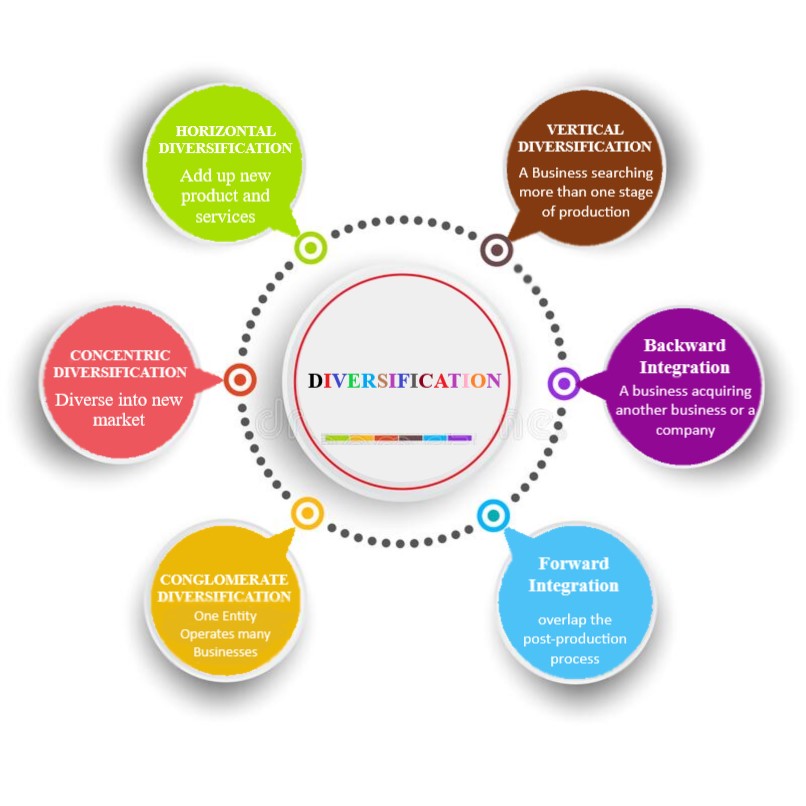
DIVERSIFICATION- Development of Product and Markets
The word diversification is defined as the change or development towards new. Diversification occurs when a business expands into a new market or develops a new product. The primary mindset of a business for diversification is to adopt progressive cultural change in the market and spread their wings while marking their footprints in multiple markets. Often Businesses diversify to increase their productivity to get the maximum output from the business. On the other hand, businesses get more versatility in the market by working on various products and services. Here in this article, you’ll find types of diversification in marketing.
In addition to achieving higher profitability, many businesses choose to diversify for multiple other reasons. For instance, diversification can also help a business minimize the risk of an industry downturn, boost brand image, and be used as a defense mechanism to protect a company from solid competition.
TYPES OF DIVERSIFICATION IN MARKETING:
Diversification is considered the modernization in this era, and many businesses develop strategies to diversify them-self and using multiple types of diversification. Some of these types of diversification in marketing are described below:
HORIZONTAL DIVERSIFICATION
When a business wants to add new products or services unrelated to the existing one or different from the existing offer product or services but may resemble the needs of your current or existing customers. In that case, this type of diversification is known as Horizontal Diversification.
In horizontal diversification, a minimum amount of risk is involved as the business works primarily within familiar customers and market segments that may help the company grow most effectively and efficiently. On the other hand, the retain customers remain the same.
VERTICAL DIVERSIFICATION
Vertical diversification is one of the most highlighted types of diversification. A business moves up or down by combing its operations or by searching more than one stage of production, which separate companies operate. Through this, the firm takes over some or all the functions related to the production and distribution of their core product, such as manufacturing process, assembly, purchase of raw material, distribution, and sales.
Vertical diversification is also known as vertical integration, which is further divided into two categories backward and forwards integration:
Backward Integration
Backward integration is a subdivision of Vertical integration. A business acquiring another business or a company that makes an input product for the acquiring company’s product, such as a mobile manufacturing business, acquire mobile accessories manufacturing company which is beneficial for an existing business or company.
Forward Integration
Forward integration occurs when an existing business tries to overlap the post-production process, so the industry stays a step ahead of the competitors. This process makes the manufacturer closer to the consumer and gives the company more revenue in the long run, and the business can grow more effectively and progressively.
Vertical integration not only maximizes the profit from the newly acquired operations, but it also increases the production process’s efficiency and fastens the process of Logistics while cutting down the delay in delivery.
CONCENTRIC DIVERSIFICATION
Concentric diversification is a type of diversification in which a business enters a whole new market dimension with a new product that might be technologically similar to the existing product. Therefore, the business can raise some advantage by leveraging products or services as industry experience. On the other hand, the manufacturing process and other technical stuff remain in the process.
Concentric diversification can be beneficial for the business when the sales are increasing for one product. It overlaps the sales of other products, which is in a declining phase, as loss in revenue can be offset by a rise in sales from other products.
CONGLOMERATE DIVERSIFICATION
Conglomerate Diversification is when a business is looking to move forward and diversify into entirely new markets with totally unrelated products to get a wholly unique experience. It might be harmful to many businesses because it is riskier compared to other types of diversification as in this a business jump into the whole new pool of product.
In Conglomerate Diversification, a single corporate group operates multiple business entities within entirely different market segments to spread their wings into numerous market dimensions. The parent company in which all these business entities are working together is known as “Conglomerate.” The parent company is successfully implementing the conglomerate diversification and operates all these entities as one.
FINAL WORDS:
In the business world, there is no “one strategy fits all” solution for growth. Diversification represents itself in various forms depending on the direction a business wishes to move in. It can be related or unrelated to the existing product or services that a business can currently offer.
In other words, through diversification, a business attains a long-term expansion in multiple dimensions of the market and expands itself in highly different ways. By expanding their reach and appeal, businesses can explore new avenues for sales, and in turn, have the potential to increase their profits vastly.
See also Top 10 agriculture trends 2022




Has anybody shopped at Vapin’ the 619? xx
Has anyone ever been to Viking Vapor Ecigarette Shop in 2438 Sandmine Rd.?